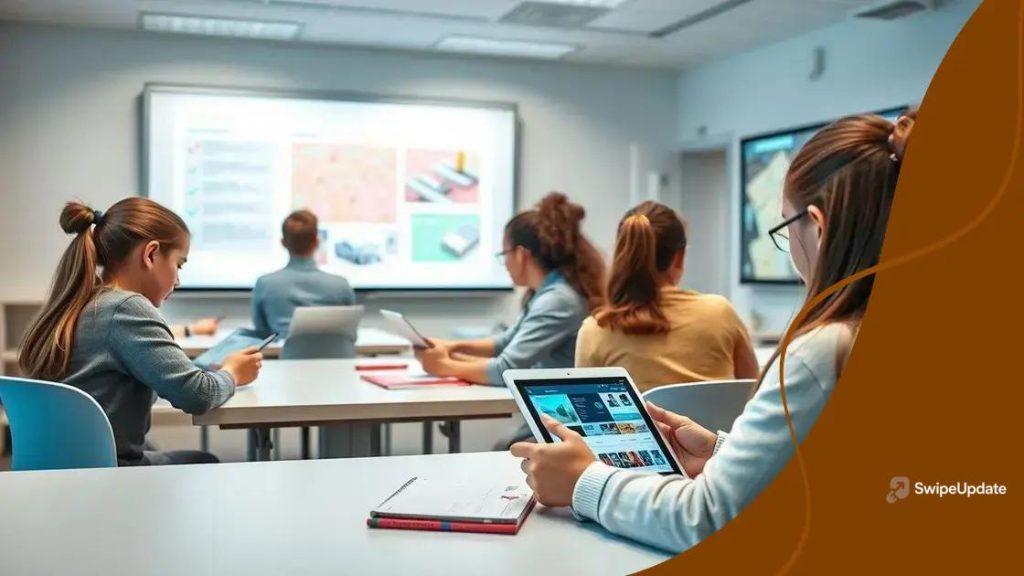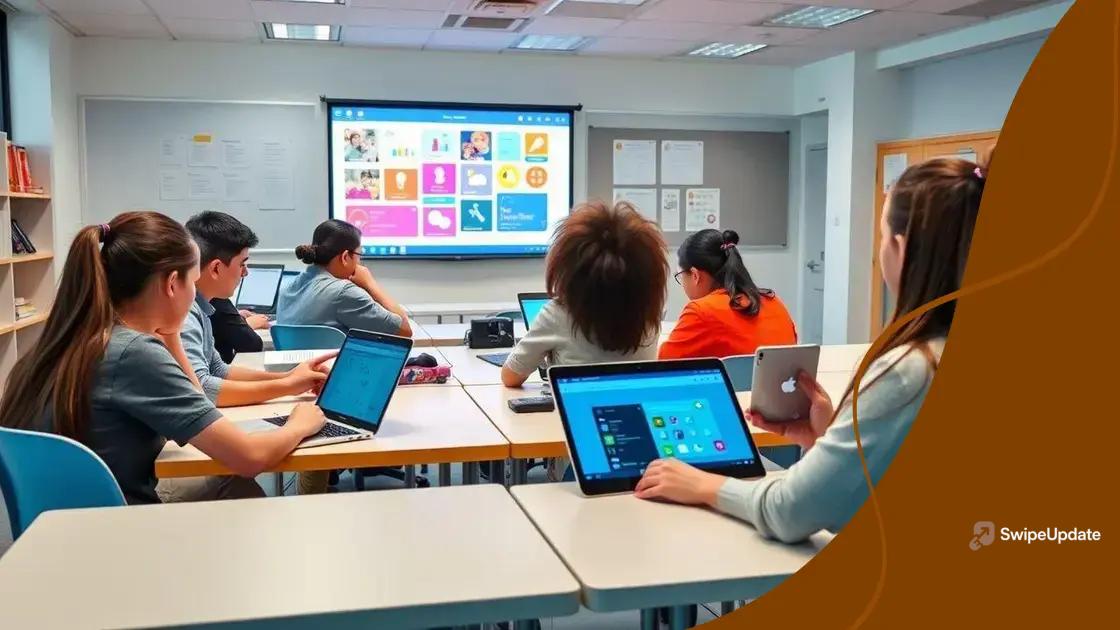The impact of technology on teaching methods

The impact of technology on teaching methods significantly enhances student engagement, accessibility, and personalized learning experiences, while also presenting challenges such as equitable access and the need for adequate teacher training.
The impact of technology on teaching methods is profound, transforming classrooms into dynamic learning spaces. Have you ever wondered how these changes affect students and teachers alike? Let’s dive in!
Understanding the role of technology in education
Understanding the role of technology in education is essential in today’s learning environments. Technology is more than just a tool; it’s a vital part of how students learn and engage with materials. A classroom enhanced by technology can ignite curiosity and foster collaboration among students.
Enhancing Student Engagement
One major benefit of technology is its ability to make learning more engaging. With the use of interactive tools and resources, students can experience lessons in a dynamic way. For instance, virtual reality can transport students to historical sites while they study them.
Tools That Facilitate Collaboration
Technological tools allow for seamless collaboration among students. Group projects can be managed more efficiently with collaborative platforms. Here are some tools that enhance teamwork:
- Google Docs for real-time editing
- Slack for communication
- Trello for project management
- Kahoot for interactive quizzes
These tools make working together easier, enabling students to share ideas and work more efficiently.
Additionally, technology supports differentiation in teaching methods. Educators can tailor lessons to meet the diverse needs of their students. For instance, using multimedia resources can cater to visual and auditory learners effectively. This variety helps keep students engaged and improves their understanding of concepts.
Access to Information
The internet provides students with unprecedented access to information. They can explore subjects in-depth and utilize reputable online resources for their research. This not only broadens their knowledge but also teaches them how to discern credible sources, a necessary skill in our information-rich society.
Moreover, technology offers opportunities for continuous learning beyond the classroom. Online courses and educational platforms enable students to pursue interests at their own pace, fostering a love for learning that extends well beyond traditional schooling.
In summary, technology plays a transformative role in education. By enhancing engagement, enabling collaboration, supporting differentiation, and providing access to vast resources, technology empowers students and educators alike. Such tools are helping shape a more interactive and enriched learning experience altogether.
How technology shapes modern teaching methods
How technology shapes modern teaching methods has become increasingly relevant in today’s educational landscape. With the advancement of digital tools, educators can enhance their teaching techniques significantly. They are not only adapting to new technologies but also transforming the entire learning process.
Blended Learning Environments
One approach that has gained popularity is blended learning. This method combines traditional face-to-face instruction with online learning activities. Students benefit from flexible schedules and personalized learning opportunities. In a blended learning environment, teachers can:
- Monitor students’ progress through digital platforms
- Provide instant feedback on assignments
- Facilitate discussions in online forums
- Encourage collaboration with virtual group projects
This mix of methods allows students to learn at their own pace while receiving guidance from educators.
Technology-Enhanced Content Delivery
Another significant aspect of how technology shapes teaching is through enhanced content delivery. Teachers can utilize various multimedia resources to make lessons more engaging. For instance, videos, podcasts, and interactive simulations bring subjects to life, allowing students to visualize complex concepts.
As students interact with multimedia content, they may find it easier to grasp challenging ideas. Engaging lessons also lead to higher motivation and better retention of knowledge. Furthermore, diverse resources cater to different learning styles, ensuring that every student can connect with the material.
Additionally, technology allows for the integration of assessments into learning. Educators can use tools like quizzes and games to assess understanding in real time. This immediate feedback helps identify areas where students might struggle, allowing for focused instruction that addresses specific challenges.
The Role of Educational Apps
Educational apps are also transforming how students learn. These applications provide access to a wide range of learning materials and activities at their fingertips. Students can practice skills, track their progress, and engage in interactive learning experiences.
Examples include language learning apps, math practice platforms, and coding tools. Such resources empower students to take charge of their education, making learning more dynamic and enjoyable. With technology at their disposal, students become more active participants in their education.
In summary, technology shapes modern teaching methods by enabling blended learning, enhancing content delivery, and offering diverse educational resources. The impact of these innovations is profound, driving a more engaged and self-directed learning experience.
Incorporating digital tools into the classroom

Incorporating digital tools into the classroom is revolutionizing education as teachers seek to enhance student learning. By integrating various technologies, educators create an interactive atmosphere that captivates students. Digital tools not only support teaching but also engage students in new and exciting ways.
Types of Digital Tools
There are many digital tools available that schools can implement. Common types include:
- Learning Management Systems (LMS): Platforms like Google Classroom allow teachers to organize course materials and assignments conveniently.
- Interactive Whiteboards: These tools make lessons more engaging by allowing teachers to display multimedia content and interact with it in real time.
- Educational Apps: Various apps offer exercises and activities for students, covering a range of subjects from math to coding.
- Online Collaboration Tools: Tools like Microsoft Teams or Slack foster communication and collaboration among students for group projects.
These tools help create a modern and collaborative learning space where students can thrive.
Benefits of Digital Integration
Integrating digital tools into the classroom comes with numerous benefits. For example, students become more motivated when lessons utilize technology. Learning with interactive resources caters to various learning styles, making education accessible for everyone.
Additionally, the use of technology fosters essential skills like critical thinking and problem-solving. Students learn to use digital tools effectively, preparing them for higher education and the workforce.
Moreover, incorporating digital tools supports differentiated instruction, allowing teachers to tailor lessons to meet individual needs. With resources available online, educators can easily modify content to challenge advanced learners or support those who require more help.
Challenges of Implementation
While the advantages are substantial, incorporating digital tools also presents challenges. Teachers may need training to feel comfortable with new technologies. Additionally, access to technology can be uneven, resulting in disparities among students.
Ensuring that every student has equal access to digital tools is vital. Schools must invest in the necessary infrastructure to support technology integration. Furthermore, educators should regularly evaluate the effectiveness of digital tools and make adjustments as needed to enhance learning outcomes.
In essence, incorporating digital tools into the classroom transforms teaching and learning. The advantages greatly outweigh the challenges, promoting a more engaging and effective educational experience for students.
The benefits of online learning environments
The benefits of online learning environments are becoming increasingly clear as more learners and educators embrace this method of education. These environments offer flexibility, accessibility, and a range of resources that traditional classrooms may not provide.
Flexibility and Convenience
One major benefit of online learning is the flexibility it offers. Students can choose when and where to study, making it easier to balance their education with work and other commitments. This flexibility allows learners to design a schedule that fits their personal needs.
Accessibility
Another advantage is the accessibility that online learning provides. Students from remote areas or those with mobility challenges can participate in courses that might not be available locally. Accessing course materials online also means students can revisit lectures and assignments at their own pace.
- Global reach: Online learning connects students to instructors and peers from around the world.
- Diverse courses: Learners can enroll in a wide range of subjects and disciplines not offered by local institutions.
- No commute: Eliminating travel time saves students both time and money.
- Personalized learning: Students can tailor their learning experiences to match their unique preferences and needs.
This accessibility ensures that everyone has the opportunity to learn and grow, regardless of their location.
Resource Availability
Online learning environments also come with a vast array of resources. Students can access multimedia materials, such as videos, podcasts, and interactive modules, enhancing their understanding of complex topics. These resources can support various learning styles, making the educational experience more inclusive.
Moreover, online tools often provide immediate feedback on assignments, allowing learners to understand their progress quickly. This instant feedback promotes self-directed learning and helps students identify areas for improvement.
With the right online platform, collaboration among peers can occur seamlessly. Discussion boards, forums, and group projects facilitate communication and promote a sense of community among students, even in a virtual setting.
In short, the benefits of online learning environments are extensive. They provide flexibility and accessibility while offering a wide array of resources that enhance the learning experience. As technology continues to evolve, the potential for these environments to adapt and improve educational outcomes only grows.
Challenges faced with technology in teaching
Challenges faced with technology in teaching are significant and can impact how effectively educators use digital tools. While technology has great potential, it also brings a set of obstacles that must be addressed to enhance the learning experience.
Access and Equity
One of the primary challenges is ensuring equitable access to technology for all students. Not every student has a computer or reliable internet connection at home. This digital divide can lead to disparities in learning opportunities.
- Limited access: Some students may struggle to complete assignments due to a lack of technology.
- Geographical barriers: Rural areas may have weaker internet service, affecting remote learning.
- Economic disparities: Families with lower incomes might not afford necessary devices.
Addressing these issues is crucial to ensure that all students can benefit from technological advancements.
Teacher Training and Support
Another significant challenge is the need for adequate training and support for teachers. Not all educators feel comfortable using technology in their classrooms. Some may lack the skills to integrate digital tools effectively.
Providing professional development opportunities can help educators become more proficient in using technology. Training should focus on using various digital tools and understanding how to apply them to enhance student learning.
Additionally, ongoing support is vital. Teachers should have access to resources and technical assistance as they navigate new tools and platforms. This support can help build confidence in their ability to incorporate technology successfully.
Technical Issues
Technical problems can also disrupt the learning process. Issues such as malfunctioning devices, software glitches, or poor internet connectivity can hinder classroom activities.
While technology can streamline learning, it can also lead to frustration when things go wrong. Schools need to establish tech support systems and have backup plans in place to manage these failures effectively.
In conclusion, while technology offers numerous benefits for teaching and learning, challenges such as access and equity, teacher training, and potential technical issues should be acknowledged and addressed. By confronting these obstacles, educators can create a more inclusive and effective learning environment.
FAQ – Frequently Asked Questions about Technology in Teaching
What are the main challenges of using technology in education?
The main challenges include access and equity, teacher training, technical issues, and resource management.
How does technology enhance student learning?
Technology provides interactive and personalized learning experiences, allowing students to engage with materials in various ways.
Why is teacher training important for technology integration?
Adequate teacher training ensures educators are comfortable and proficient in using digital tools effectively, enhancing the learning experience.
What can be done to ensure equitable access to technology?
Schools can invest in providing devices and internet access to all students, and offer support for those who may struggle with technology.
